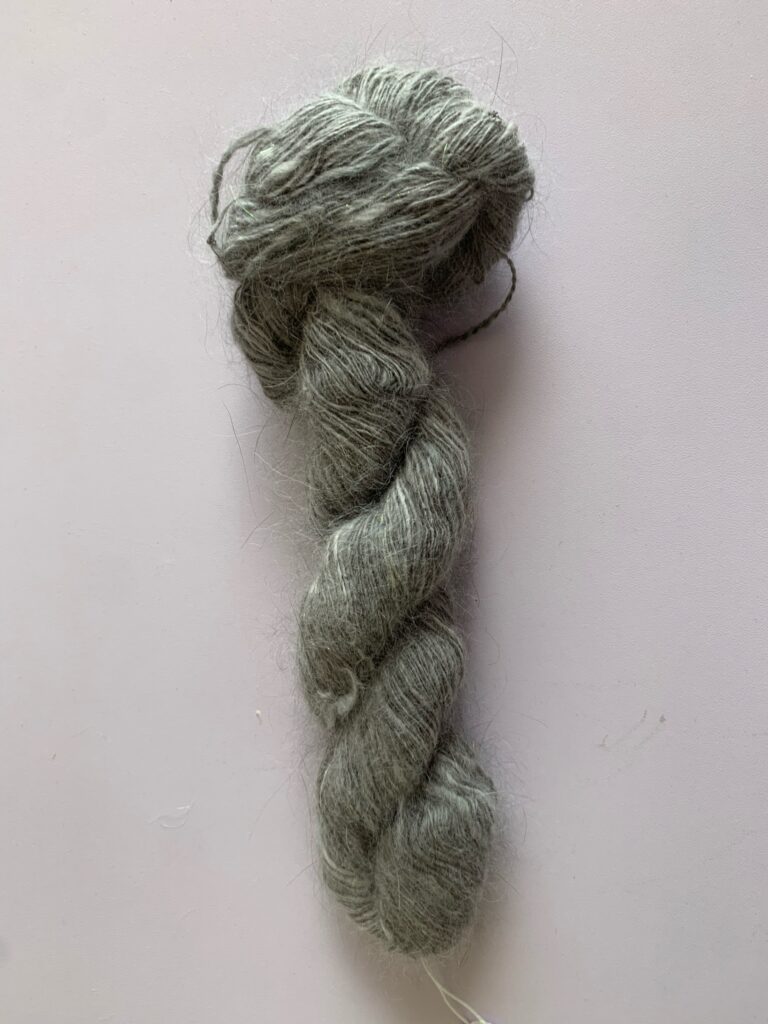
I think it safe to say that most people when they think of spinning think of little woolly jumpers running round a field! In my case it was little woolly bunnies, because I decided to keep the rabbits for exhibition first and then discovered the craft of spinning. One rabbit actually takes up a very small corner in the shed and is far less trouble than a sheep! Off a good woolly you can get 12oz – 1lb of wool a year, which will provide you with at least one (if not two!) jumpers a year. The Angora rabbit is a lovely animal, generally very placid and good natured and keeping them can be very rewarding.

Learn with sheep’s wool
If you have never spun before, it is best to learn to spin using sheep’s wool first. Sheep’s wool is much easier to spin because it has, in general, a much longer staple than Angora, and it has little barbs running along its length that helps to hold it together when it is spun. Angora is a smooth fibre and is held together purely by the amount of twist put ito the thread as it is spun. Before spinning, wool is teased out and carded (combed) using carders. This removes dirt and debris. Once carded, wool is rolled along its length forming a long coil called a rolag. The wool for spinning is taken from one end of the rolag, the fibres coming in a circular fashion making, when spun at the correct tension, a bouncy, soft yarn. To judge the correct tension, stop the wheel, let the thread twist up upon itself, and it should form one long ‘twizzle’.

Angora cannot be spun like wool
Angora cannot be spun like wool; a bouncy yarn would not hold together properly and would shed. The tension should be looser, causing a higher twist on the thread – when the thread twists up upon itself lots of little twizzles should form – in effect you are over-spinning. The threads should be very fine as chunky Angora would shed and be inclined to fall apart because of the relatively short staple and the slippery nature of the fibres. Properly spun angora should not shed. The over-spinning is counterbalanced when plying, twisting two threads together to form a yarn. The wheel is spun in the opposite direction to that used when spinning, therefore removing some of the twist from the threads.

My preferences
The following are my personal opinions and preferences. I have found that in the craft of spinning that what one person says you categorically cannot do, someone somewhere is doing just that same thing quite successfully! I do not like Angora on its own; it is too soft. I like to ply it with something else – cashmere, silk, camel or any of the ‘luxury’ fibres, or a very soft fleece such as Shetland. I do not like Angora mixed with other fleeces. As stated, they require different spinning tension. A mixture spun at wool tension would produce a soft bouncy woollen yarn, but the twist would not be sufficient to hold the Angora in place, therefore the slippery Angora fibres would slip out and shed from the yarn. Spun at Angora tension, the resultant yarn would be hard (over-spun wool produces hard yarn) except for any softness resulting from the Angora content. The luxury fibres mentioned above are all spun in the same manner as Angora and are quite suitable for mixing. My favourite is silk, the resultant yarn has a lovely lustre to it.

To obtain smooth and even colour if using coloured Angora, the wool can be blended using wool carders. I keep a pair of carders specifically for Angora; the grease from sheep’s fleece contaminates the carders and grease and Angora wool do not mix. Do not card in the same way as you would fleece, taking the wool from one carder to the other. Keeping the Angora on one carder only, gently comb with the other thereby blending the wool. Lift from the carder but do not roll. Spin from the cut end, worsted fashion (keeping the fibres all in one direction). Sweaty hands can be a problem causing the wool to matt; a little talcum powder sprinkled in the hand can overcome it. If spinning straight from the rabbit as it were, spin the cut or plucked end first. Wool can be plucked from the rabbit during moult. Only small areas can be done at a time, so it takes quite a while to remove a whole coat. Plucked wool is a minimum of 4 inches long and is therefore easier to spin. Happy spinning!
Please note
- Angora wool comes from Angora rabbits; Mohair fibre comes from Angora goats.
By Lesley Taylor is the President of the National Angora Club.